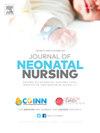采用混合方法提高电子病历中新生儿喂养记录的质量
Q2 Nursing
引用次数: 0
摘要
新生儿喂养是婴儿生长和生存的关键。准确的喂养记录可以为护理决策和护理计划提供信息。电子健康记录(EHR)中有一个营养仪表板,它在图形显示中累积喂养数据。目的提高新生儿重症监护病房(NICU)新生儿喂养文件的质量。设计与方法:建立多学科终端用户专家组(n = 38)。该小组的定性专题分析用于设计新的喂养数据输入和审查元素。定量前后设计用于评估产后病房婴儿图表(n = 134)和新生儿重症监护病房婴儿图表(n = 188)的喂养文件。使用描述性统计和Pearson卡方来评估前后差异和统计学意义。使用系统审计日志评估营养仪表板的使用,并使用泊松回归测试进行分析。结果产后病房婴儿结构化喂养记录改善91.6%(由17.9%提高至34.3%)(p = 0.031)。NICU数据喂养记录改善了25%(从72.3%提高到90.4%)(p = 0.001)。然而,营养仪表板的使用在后期有所减少。结论:本研究表明,通过多学科合作优化电子病历设计,新生儿喂养记录的质量可以得到改善。实践意义采用多学科方法进行电子病历设计的好处对于促进符合个人工作流程的高质量数据输入至关重要。本文章由计算机程序翻译,如有差异,请以英文原文为准。
Improving the quality of newborn feeding documentation in an EHR using a mixed methods approach
Introduction
Newborn feeding is key to infant growth and survival. Accurate feeding documentation can inform care decisions and planning of care. A nutritional dashboard is available within the Electronic Health Record (EHR) which accumulates feeding data in a graphical display.
Purpose
To improve the quality of newborn feeding documentation for post-natal ward babies and babies in the Neonatal Intensive Care Unit (NICU).
Design
and Methods: A multidisciplinary end user expert group (n = 38) was established. Qualitative thematic analyses from this group were used to design new feeding data entry and review elements. Quantitative pre-post design was used to assess feeding documentation for both post-natal ward baby charts (n = 134) and NICU baby charts (n = 188). Descriptive statistics and Pearson's chi-square were used to assess pre-post differences and statistical significance. The use of a nutritional dashboard was assessed using system audit logs and analyzed using Poisson regression testing.
Results
Post-natal ward babies had improvements in structured feeding documentation by 91.6% (from 17.9% to 34.3%) (p = 0.031). NICU data feeding documentation improved by 25% (from 72.3% to 90.4%) (p = 0.001). Use of the nutritional dashboard however reduced in the post period.
Conclusion
This study has positively demonstrated improvements in the quality of newborn feeding documentation within the patient's EHR can be achieved through a collaborative multidisciplinary approach optimising EHR design.
Practice implications
The benefit of a multidisciplinary approach to EHR design is paramount to promoting superior quality data entry compliant with individual workflows.
求助全文
通过发布文献求助,成功后即可免费获取论文全文。
去求助
来源期刊

Journal of Neonatal Nursing
Nursing-Pediatrics
CiteScore
2.00
自引率
0.00%
发文量
143
期刊介绍:
Aims & Scope: This is the practical, bimonthly, research-based journal for all professionals concerned with the care of neonates and their families, both in hospital and the community. It aims to support the development of the essential practice, management, education and health promotion skills required by these professionals. The JNN will provide a forum for the exchange of ideas and information between the range of professionals working in this field; promote cooperation between these professionals; facilitate partnership care with families; provide information and informed opinion; promote innovation and change in the care of neonates and their families; and provide an education resource for this important rapidly developing field.
 求助内容:
求助内容: 应助结果提醒方式:
应助结果提醒方式:


